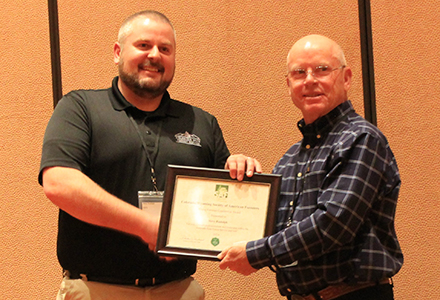
CSFS Staff Recognized for Outstanding Work
The Colorado-Wyoming Society of American Foresters met in Loveland, Colo., on March 21, 2024, and three CSFS employees received awards for their achievements in forestry.
Counties most impacted in northwest Colorado in 2023: Garfield
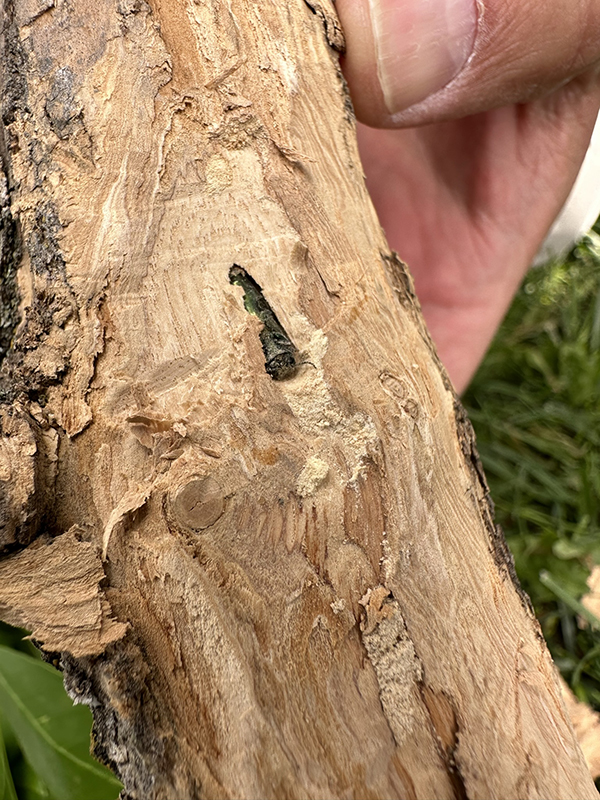
In June 2023, experts from Colorado State University confirmed the presence of emerald ash borer (Agrilus planipennis) in the town of Carbondale in Garfield County. While this insect has been present on Colorado’s Front Range since 2013, the detection in Carbondale marks the first time emerald ash borer has been confirmed in western Colorado.
This non-native, invasive pest poses a serious threat to urban forests in Carbondale and surrounding areas. Emerald ash borer attacks and kills both stressed and healthy ash trees. It is so aggressive that trees typically die within two to four years after becoming infested, if untreated.
Carbondale’s tree inventory includes approximately 470 ash trees on public property with even more ash trees on private property. Emerald ash borer likely made its way to Carbondale in infested ash firewood, which is why people should always buy firewood locally and not transport it far from home.
With this confirmation in northwest Colorado, communities in the Roaring Fork Valley should be on the lookout for signs of emerald ash borer infestation in ash trees and contact their local municipal forester, CSFS office or CSU Extension office for confirmation. The CSFS offers resources and guides to help residents and arborists detect, treat and plan for this deadly insect.
Counties most impacted in northwest Colorado in 2023: Delta, Garfield, Mesa, Pitkin
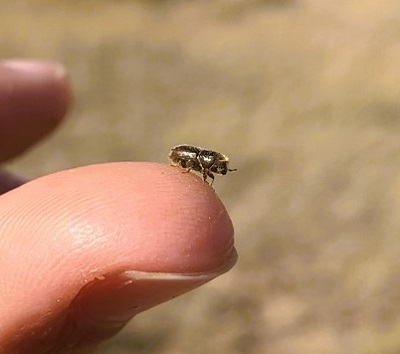
Piñon Ips beetle (Ips confusus) continues to attack stands of piñon trees in northwest Colorado. This native insect rarely attacks healthy trees, but periods of below-average precipitation and warmer-than-average temperatures have weakened piñon trees, making them susceptible to the beetle. Construction activities that damage trees and compacted soils have also led to its spread in certain areas.
The piñon Ips beetle can be especially deadly when conditions favor its spread and weaken trees. The beetle can mass attack stands of piñon pine trees and kill them in a single season.
Areas most impacted by this beetle in this part of the state include piñon-juniper forests in the Glade Park and Gateway Canyon areas of Mesa County, the Cedaredge area of Delta County, and around Rifle and Glenwood Springs in Garfield County. Localized pockets of mortality are evident in parts of the Roaring Fork Valley leading into and around Aspen in Pitkin County.
Colorado State Forest Service foresters offer science-based strategies and education to help landowners and public land managers address piñon Ips beetle. Actively managing a forest can enhance stand structure and vigor to keep this beetle from establishing large populations. Landowners should prune piñon trees from November to February when the beetles are inactive. It is also critical to properly dispose of cut wood and slash, which can be ideal breeding sites for this beetle.
Counties most impacted in northwest Colorado in 2023: Eagle, Garfield, Mesa, Pitkin
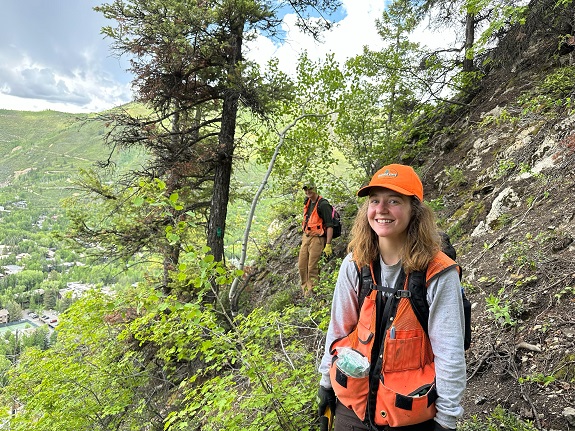
For the second year in a row, the Colorado State Forest Service teamed with the City of Aspen and its partners to hang pheromone packets in the forests surrounding Aspen. It is strenuous work, but these packets will help ward off Douglas-fir beetles (Dendroctonus pseudotsugae) from killing large swaths of Douglas-fir trees on the scenic mountainsides around the city.
Years of drought have left Douglas-fir trees in and around Aspen and elsewhere in northwest Colorado susceptible to outbreaks of this native bark beetle. The beetle heavily affected Douglas-fir forests in Eagle, Garfield, Mesa and Pitkin counties in 2023 and has increased activity in the Roaring Fork Valley since the Lake Christine Fire in 2018.
Pheromone packets attached to healthy trees are one form of treatment for Douglas-fir beetle. They act as a no vacancy sign by mimicking a chemical emitted by the beetles when they infest a tree. Packets will be available through the CSFS in early 2024. Please get in touch with your local CSFS office for more information.
Other management strategies include thinning dense stands of trees to reduce competition for resources, increasing individual tree vigor, and removing wind-thrown and already infested trees.
Counties most impacted in northwest Colorado in 2023: Eagle, Garfield, Grand, Jackson, Mesa, Pitkin, Rio Blanco, Routt
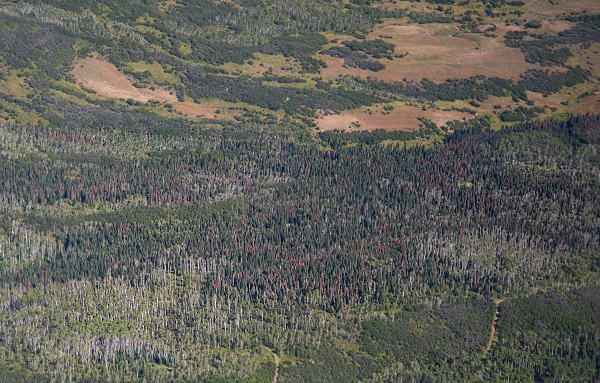
Subalpine fir continues to decline across high-elevation forests in northwest Colorado, thanks to the killer combination of western balsam bark beetle (Dryocoetes confusus) and fungi that cause root decay. Despite ample precipitation and periods without drought in this part of the state last year, subalpine fir trees have not fully recovered their defenses from prior years of drought.
Trees killed by western balsam bark beetle have a reddish tinge and can stick out in patches of green, healthy trees. Infestations of the beetle can be patchy within a stand, so they are noticeable.
Locations in northwest Colorado most impacted by this beetle in 2023 include Rabbit Ears Pass and forests within the Flat Tops in Routt, Rio Blanco and Garfield counties. The Roaring Fork Valley leading to Aspen in Pitkin County has seen notable tree loss in recent years. Berthoud Pass and the Vasquez Peak Wilderness in Grand County continue to experience heavy tree mortality from this bark beetle.
Beetle-killed trees fall and present hazards for hikers, hunters, bikers and others recreating in forests. Newly infested trees can be removed prior to the adult western balsam bark beetles emerging the following summer to infest other trees. However, management is a challenge because of the low value of the wood to offset treatment costs, spotty and unpredictable infestations, and remote and steep terrain at high elevations that is difficult to access.

The Colorado-Wyoming Society of American Foresters met in Loveland, Colo., on March 21, 2024, and three CSFS employees received awards for their achievements in forestry.
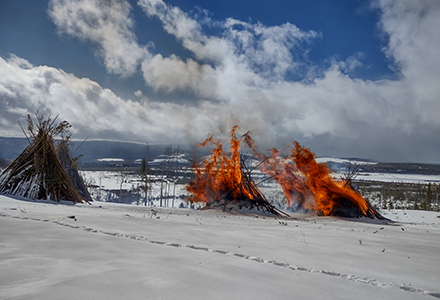
When foresters complete forest management and fuels reduction treatments, they sometimes pile up the leftover, non-merchantable material. Trained Colorado State Forest Service personnel then burn these piles as an economical and effective method of disposing of excess wildland fire fuels.
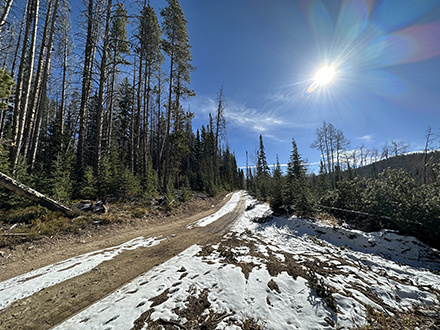
The GNA program lets the U.S. Forest Service enter into agreements with state forestry agencies to pool resources to complete critical, cross-boundary work that improves forest health, reduces wildfire risk and protects watersheds. In north Routt County, partnering with the CSFS helps the U.S. Forest Service access land-locked federal forest, reachable only with agreement of residents whose private lands surround it.